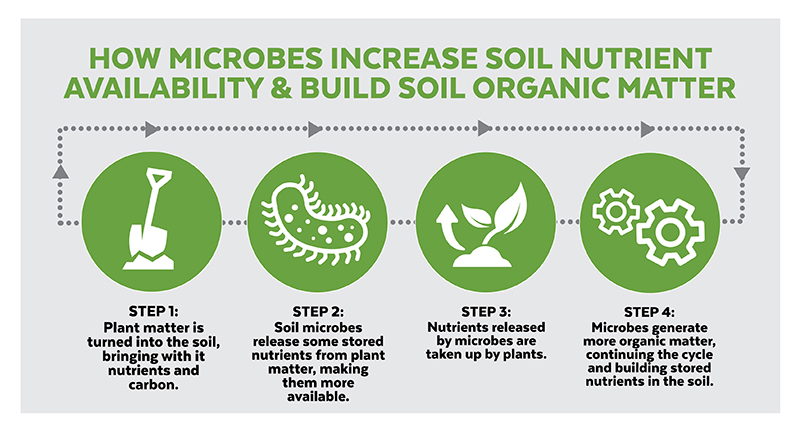Healthy, productive soils have large pools of stable soil organic matter. Soil organic matter (SOM) is key to plant drought resistance and sustainable food production. Understanding how to build and maintain soil organic matter is key to achieving high crop yields, while also maintaining healthy soil structure and reducing nutrient loss.
Soil Microbes & SOM Formation
Research done at the University of New Hampshire is shedding new light on the role that microbes play in the formation of soil organic matter.1 Their research suggests that SOM is a mixture of dead microbial cells and the byproducts formed when microbes breakdown plant roots and residues, rather than coming directly from the plants and residues themselves.
It is now understood that microbes play a key role in converting crop residues and other inputs in the soil ecosystem. Microbes (bacteria and fungi) can take carbon sources (sugars, plant material) and convert them to various organic molecules such as proteins, lipids, and complex sugars. It is these that make up the bank of SOM, or soil humus, from which we derive agronomic benefit.
In fact, even when microbes were fed only table sugar, the SOM that was produced was nearly identical to the SOM found naturally in fields. This is an important step in understanding SOM formation because knowing whether a particular molecule of SOM came from a plant or a microbe, once it is formed, is practically impossible.
Healthy Microbes, Healthy Soils
The microbes that are present in the soil drive this process — more so than the actual soil type. This means that if you focus on the health of the soil microbiome, you can build soil health. Microbial communities and soil types differ from field to field and even within fields. And with these changes, the rate and type of SOM formation changes. What does not change, however, is that healthy, diverse soil microbial communities supported by good agronomic practices drive healthy, diverse organic matter formation in the soil.
Fertility plans should account for crop residue and nutrient removal to build soil health and fertility. By focusing on the health of the soil and the microbial communities in the soil, we are most likely to optimize soil organic matter formation, increase crop yields and improve plant health.2
Many actions can be taken to preserve and rebuild soils to maximize the retention and recycling of organic matter and nutrients.3 This can be accomplished by minimizing losses to leaching, runoff and erosion through reduced tillage, diverse crop rotations and fertilizer selection.4
References:
1. Kallenbach CM, Frey SD, Grandy AS. Direct evidence for microbial-derived soil organic matter formation and its ecophysiological controls. Nature Communications (2016) 7:13630, DOI: 10.1038/nommons13630
2. Amaranthus M, Allyn B. Healthy Microbes, Healthy People. The Atlantic. June 11, 2013.
3. Bot A and Benites J. The importance of soil organic matter. FAO Soils Bulletin. Food and Agriculture Organization of the United Nations. (2005)
4. Cookson WE, Murphy DV, Roper MM. Characterizing the relationships between soil organic matter components and microbial function and composition along a tillage disturbance gradient. Soil Biology and Biochemistry (2008) 40: 763-777.

